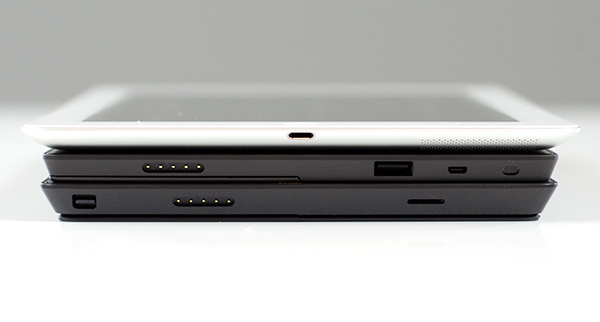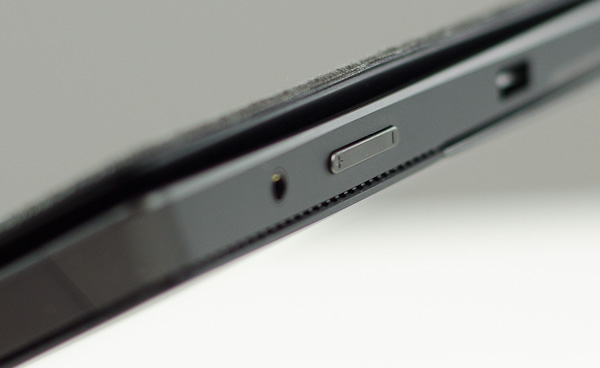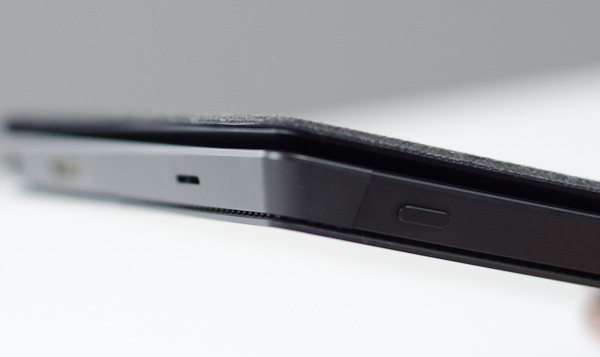Microsoft Surface Pro Review
by Anand Lal Shimpi on February 5, 2013 9:00 PM ESTSurface Pro Design
When I first saw Surface Pro, the Microsoft rep giving me the demo did a simple test. He stood Surface Pro right next to Surface, with the same start screen, and asked me if I could tell the two apart. The planar dimensions of Surface Pro are identical to Surface RT. Both feature the same sized 10.6-inch display, the same capacitive Windows button and the same 1-inch border around the screen. Looking head on, the only way you can tell the difference between Surface Pro and RT is the former’s 1080p display does make text a bit sharper.

Surface RT (left) vs Surface Pro (right)
Turn the two tablets to the side and the differences quickly become evident. Surface Pro is over 40% thicker than Surface RT (13.7mm vs 9.3mm). While the latter was of a similar thickness to an iPad with Retina Display, Surface Pro is clearly in a different league of dimensions.
The thickness of Surface Pro doesn’t really impede its portability, but the weight definitely makes it a lot less pleasant to carry around. Surface RT was already heavier than the competition but it hid its weight well. Surface Pro is just heavy for a tablet. I wasn’t originally impressed by the Surface RT form factor, but in switching between the RT and Pro models I immediately wish that Surface Pro came in the RT chassis and Surface RT came in something even thinner and lighter.

Surface Pro (left) vs. iPad 4 (right)

From top to bottom: iPad 4, Surface RT and Surface Pro
Shift the comparison to Ultrabooks however and all of the sudden Surface Pro seems quite light. It’s lighter than an 11-inch MacBook Air and Acer’s 11.6-inch Aspire S7 (although with optional keyboard cover it is heavier). It’s all about perspective. Compared to an iPad, Surface Pro is heavy, but compared to an Ultrabook or MacBook Air it’s light. The Pro model embodies the vision Microsoft had for the Surface family: to create a new type of device somewhere between a tablet and a notebook. That’s not to say there’s not room for improvement in the physical department. Surface Pro will likely go on a diet as it’s given more power efficient silicon, but even then you’ll always be able to build something thinner and lighter based on slower hardware, or go thicker and heavier with a notebook.
The fit and finish of Surface Pro are just as good as Surface RT. The tablet is built out of the same injection moulded Magnesium process (VaporMg) as Surface RT, however the chassis itself is somewhat simplified. While Surface RT featured three discrete VaporMg components (frame, back and kickstand), Surface Pro is made up of only two (single piece frame+back and kickstand). The result is no different to the end user, but the simplification on the assembly side is likely better for Microsoft.
I am fine laying the same praise on Surface Pro’s build quality as I did on Surface RT. The unique finish doesn’t feel like the aluminum we’re used to seeing on iPads, and definitely feels better than the plastic we’ve seen elsewhere. The VaporMg surface doesn’t feel like it would scratch easily, and after a few months with Surface RT I don’t see any visible scratches on my unit.
Surface Pro’s construction feels more utilitarian and understandably more oriented towards productivity, just like its little brother. I still believe that the Surface lineup is as much about Microsoft showing that it too can build high quality devices as it is about getting into the tablet market. If we compare it to the iPad, Surface Pro feels just as well built, if we compare it to every Windows RT and Windows 8 tablet or notebook on the market today - it’s worlds better. Say what you will about Microsoft entering the PC hardware business, but as of today Microsoft builds the best Windows RT and Windows 8 hardware on the market. If I ran a PC OEM I wouldn’t be angry at Microsoft, I’d be angry at myself for letting this happen.
Surface Pro retains the integrated kickstand from Surface RT, although the kickstand has been beefed up to accommodate the heavier tablet. Surface Pro’s kickstand keeps the device propped up at a fixed angle of 26-degrees away from the vertical axis. The rear facing camera is also angled to compensate (it shoots parallel to the ground with the kickstand opened).
The kickstand is allegedly good for over a million open/close cycles and it still doesn’t feel like something that would break. There are only two hinges in the kickstand compared to three for the RT model.
The kickstand on Surface Pro feels different than the kickstand on Suface RT. The Pro kickstand feels lighter and sounds less like metal and more like plastic if you tap on it. Feel around on the underside of the kickstand and you’ll notice a coating that seems to dampen sound and perhaps add some structure reinforcement to the design. Microsoft had to thicken the kickstand to support the added weight of the Surface Pro, but the difference is on the order of a fraction of a millimeter.
The tweaked kickstand does have different acoustics than Surface RT’s kickstand. While the latter sounded a lot like a thin metal door shutting, the Pro’s kickstand is far more muffled. I’d almost say it’s preferable.
Thankfully the kickstand’s functionality hasn’t been marginalized in the transition to the Pro. It’s still a highly integrated and very important part of the Surface experience. It’s simple to flip out and perfect for use on desks. You can make the kickstand work on your lap or chest if you’re lying down, but it’s not ideal for either unfortunately.
The more I use Surface (Pro and RT) the more I feel that Microsoft needs to pursue something a bit more flexible than the fixed 26-degree kickstand. The biggest issue by far is in-lap use with one of the keyboard covers attached. Depending on your seating position, the 26-degree angle that the kickstand opens at might be too small. Mechanically I don’t know the right solution for Microsoft but I do feel like for the kickstand to realize its true potential, it needs to be able to open and hold at multiple angles. It doesn’t necessarily need to have support for infinite angles, maybe even a few would work, but I do believe it’s necessary going forward.













228 Comments
View All Comments
Doominated - Wednesday, February 6, 2013 - link
God forbid you have to play games just likeoh my god
every other device has to play games
People that want to play battery killing games are obviously going to carry a secondary charger with them, as well as a halfway decent portable keyboard/mouse. This is a limitation EVERY "mobile gamer" would have to deal with, not just one who has a Surface Pro.
remain_insane - Wednesday, February 6, 2013 - link
That is what I am talking about, not play touch based games, unless baldur's gate gets ported to windows 8. Or even carry an xbox controller with you when you are on the go! There are a lot of games that have seemless controller support(with other games that don't). You can even search steam for games with controller support. I am by no way implying that this is a gaming machine, but it will work quite nicely with the rise of a lot of indie games, and older games with controller support. A lot of games on steam backup save files to the cloud so you don't have to swap save files around from one machine to the other. This is just my 2 cents, sorry I was not as clear originally.sweenish - Wednesday, February 6, 2013 - link
So, thought I'd chime in and mention the fact that most games require you to just click on the screen, and maybe use some hotkeys. But plenty of games are purely mouse driven, and for those, touch translates beautifully.Pfffman - Wednesday, February 6, 2013 - link
Gaming benchmarks in general seem to have been missed, we could have some graphs and numbers.Still looking forward to the case where we can plug in a tablet a the end of the day to keyboard, monitor and mouse and just use it as a desktop. Almost could do it for this, just a bit cumbersome not to mention space management would be a pain.
PsychoPif - Wednesday, February 6, 2013 - link
I agree. It's the only thing missing from an otherwise perfect review.I'm hoping that the Surface Pro get revisited as a portable gaming PC. I'm obviously not talking FPS, but League of Legend, FTL, and others would be games I'd like to play on the go.
Netscorer - Wednesday, February 6, 2013 - link
If you want to understand a gaming performance, look at any ultrabook review. Surface is not going to be magically any different, except that you should not expect to go very far on battery alone and once you connect it to the charger, one of the biggest advantages of Surface (portability) vanishes.The Ivy Bridge CPUs come with Intel HD4000 GPU and it is OK for older games (2009 and earlier) and only on reduced resolutions and medium to low settings.
My personal experience gaming on ultrabook:
Skyrim - no go
Fallout: New Vegas - on reduced resolution and minimum settings
Bioshock - reduced resolution
Medieval Total War - medium settings + reduced resolution
Civ V - minimum settings, no need to reduce resolution (and it is touch friendly game, hurray!)
Sorry, I don't play shooters or auto racers, so can not comment on these.
TheinsanegamerN - Thursday, August 8, 2013 - link
Skyrim is playable on the surface pro on lowest settings at 720p. plays pretty well given the limitations.oolzie - Wednesday, February 6, 2013 - link
Baldurs Gate Enhanced works fantastically on these devices. Granted its' not "high end", but it definitely shows how cool a game like that can be on a touch enabled device. Give it time.Doominated - Wednesday, February 6, 2013 - link
This review is, far and away, the best review of the Surface Pro I've seen of the 15 or so I've read. The other reviews all mostly regurgitate the same exact information; It runs fast, it has Ultrabook specs, it has "poor" battery life, it can't sit on your lap easily, It's too thick/heavy to be a tablet, so on and so forth, all the stuff we've known for the past TWO MONTHS.The only thing I felt was lacking between all the graphs about color calibration and wifi range and whatnot was how altering system settings would change your expected battery life. For example, assuming the battery tests were being done @ 1920x1080 with ~65% brightness, how long would the battery last if you turned it down to 1600x900 @ 40% brightness? How does the battery do with WiFi turned off? Can we expect significantly better battery life if we stay away from a desktop internet browser?
Obviously, making compromises isn't supposed to be what the device is about, but I wouldn't mind doing a little bit of power management if it means I can consistently get 7-8 hours of battery out of it.
Outside of that though, fantastic review. The WiFi speed chart blew me away; I would have NEVER assumed there was going to be that large of a gap. Really unique info in this review that other reviewers would have never thought of to work out, a lot of which is lowkey important in how the device is going to be used on a day to day basis.
Cygni - Wednesday, February 6, 2013 - link
This is a clear compromise product. Awkward to use as a laptop, awkward to use as a tablet. You know what happens to compromise products? Well, just ask Microsoft with the RT they just released.They fail.